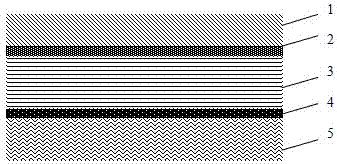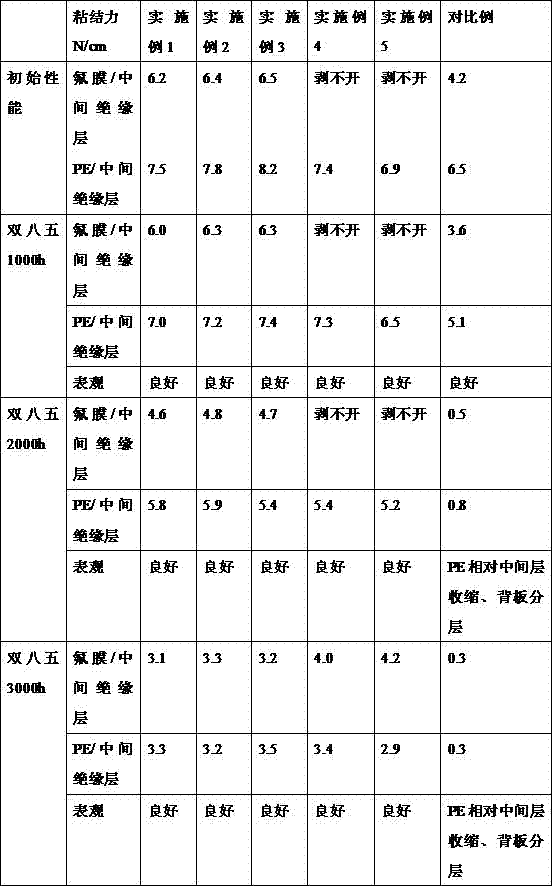A kind of adhesive composition and solar battery back sheet
A composition and adhesive technology, applied in the field of solar cells, can solve the problems of the adverse effect of the adhesive and the intermediate insulating substrate, the adverse effect of the storage stability of the adhesive, poor hydrolysis resistance, etc., and achieve excellent moisture and heat resistance. Aging performance, excellent hydrolysis resistance, the effect of ensuring mixing uniformity
- Summary
- Abstract
- Description
- Claims
- Application Information
AI Technical Summary
Problems solved by technology
Method used
Image
Examples
Embodiment 1
[0049] The adhesive composition of the present invention comprises 10g of methyl methacrylate, 70g of ethyl acrylate, 10g of butyl methacrylate and 10g of methacrylate-2-hydroxyethyl methacrylate at a temperature of 70°C. The amount of diisobutyronitrile initiator is 1.6g, the content of lauryl mercaptan is 0.3g, and the reaction time is 2h. The obtained (meth)acrylate polyol has a molecular weight of 9000 and a Tg of -10°C, and weighs 24g; 14g dimethyldiethoxysilane, 80g ethyl acrylate and 6g acrylate-4-hydroxybutyl acrylate react at a temperature of 80°C, the lauryl mercaptan content is 0.4g, and the amount of benzoyl peroxide initiator is 1.3g, the reaction time is 2.5h to obtain silicone modified (meth)acrylate resin, the molecular weight is 12000, Tg is -5 ℃, weigh 1.6g; manufactured by BASFCorp IRGANOX1010 (trade name) four [3-( 3,5-di-tert-butyl-4-hydroxyphenyl) propionate] pentaerythyl alcohol ester, the content is 0.3 g, and the isocyanate compound B is N3390 (trade n...
Embodiment 2
[0053] The adhesive composition of the present invention comprises 5g methyl methacrylate, 80g isobutyl acrylate, 5g cyclohexyl methacrylate, 5g glycidyl methacrylate and 5g 2-hydroxyethyl methacrylate Under the reaction at a temperature of 75°C, the content of lauryl mercaptan is 0.34g, the amount of azobisisobutyronitrile initiator is 1.8g, and the reaction time is 1.5h. The obtained (meth)acrylate polyol has a molecular weight of 8000, Tg is -2°C, weigh 17.6g; 16g of methyl acetoxysilane, 80g of ethyl acrylate and 4g of 4-hydroxybutyl acrylate at a reaction temperature of 90°C, the amount of lauryl mercaptan is 0.4g, persulfuric acid The amount of the ammonium initiator is 1.0 g, and the reaction time is 4 h. The obtained silicone-modified methacrylate resin has a molecular weight of 25,000 and a Tg of 8°C. Weigh 1.5 g; IRGANOX1076 (trade name) manufactured by BASF Corp. 3 - n-octadecyl (3,5-di-tert-butyl-4-hydroxyphenyl) propionate, content 0.5 g, content of UV absorber 2-...
Embodiment 3
[0057] The adhesive composition of the present invention comprises 5g methyl methacrylate, 70g ethyl acrylate, 12g cyclohexyl methacrylate and 3g methacrylate-2-hydroxyethyl methacrylate at a reaction temperature of 80°C, lauryl sulfur The alcohol content is 0.4g, the potassium persulfate initiator is 1.4g, and the reaction time is 2.5h. The obtained (meth)acrylate polyol has a molecular weight of 10,000, a Tg of -5°C, and a weighed mass of 23.6g; The reaction temperature of alkoxysilane, 70g isobutyl acrylate and 10g-3-hydroxypropyl acrylate at 85°C, the content of lauryl mercaptan is 0.35g, the amount of azobisisobutyronitrile initiator is 1.3g, and the reaction time A silicone-modified methacrylate resin obtained by reacting the acrylate polyol obtained in 3 hours, with a molecular weight of 15,000, a Tg of 3°C, and a weighed mass of 2.5 g; manufactured by BASF Corp. IRGANOX1076 (trade name) 3-(3, n-octadecyl 5-di-tert-butyl-4-hydroxyphenyl) propionate, content 0.18 g, TINU...
PUM
| Property | Measurement | Unit |
|---|---|---|
| glass transition temperature | aaaaa | aaaaa |
| thickness | aaaaa | aaaaa |
| thickness | aaaaa | aaaaa |
Abstract
Description
Claims
Application Information
 Login to View More
Login to View More - R&D
- Intellectual Property
- Life Sciences
- Materials
- Tech Scout
- Unparalleled Data Quality
- Higher Quality Content
- 60% Fewer Hallucinations
Browse by: Latest US Patents, China's latest patents, Technical Efficacy Thesaurus, Application Domain, Technology Topic, Popular Technical Reports.
© 2025 PatSnap. All rights reserved.Legal|Privacy policy|Modern Slavery Act Transparency Statement|Sitemap|About US| Contact US: help@patsnap.com


